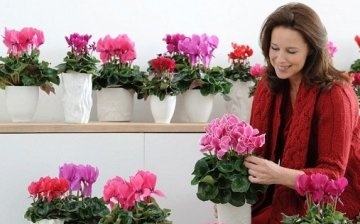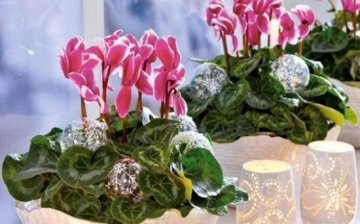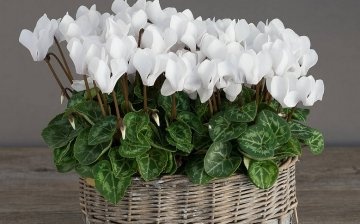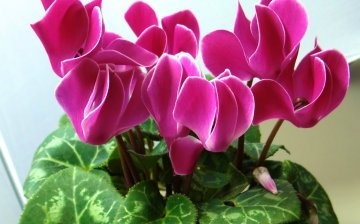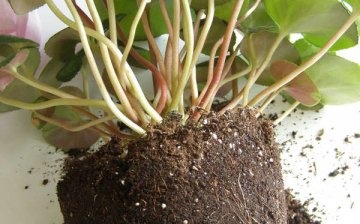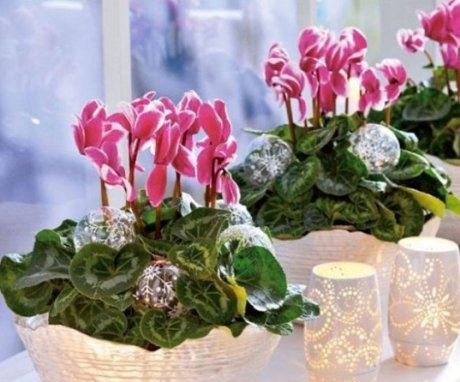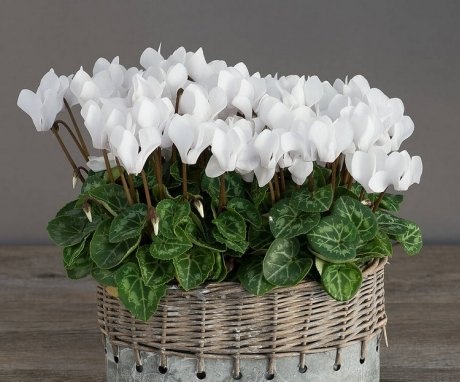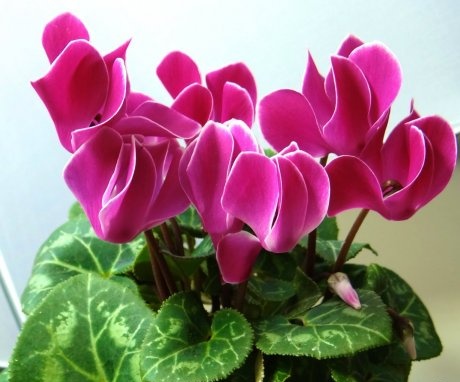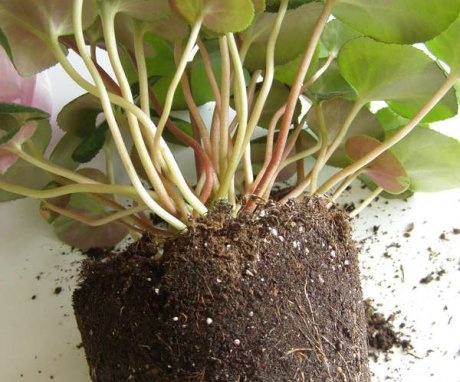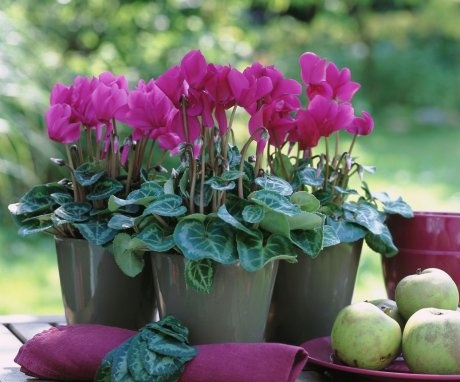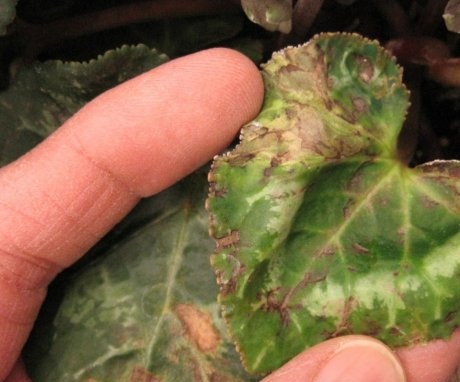Handsome cyclamen: how to care for a houseplant
In the cold winter season, you always want to please the eye with the bright flowering of beautiful plants. One of these rare and amazing winter flowers is cyclamen... Its unearthly beauty inflorescences bloom in late autumn and delight the owners throughout the harsh winter. An unusual flower can cheer you up and dispel the seasonal blues.
Growing it brings joy and pleasure. Many people ask experienced florists "How to care for this delicate flower?" Cyclamen is considered quite capricious, but with proper care and watering, there are no problems with it. This short guide to the care and cultivation of cyclamen will help both novice growers and experienced growers. Useful tips will help you grow and propagate one of the most beautiful winter flowers - cyclamen.
Content:
- Description of cyclamen
- Popular species for cultivation
- Growing conditions
- Reproduction and transplantation
- Cyclamen care
- Diseases and pests
Description of cyclamen
Cyclamen grows wild in the Mediterranean, Africa and the Middle East. Also, the plant can be found in the Crimea and some regions of Ukraine. In our country, cyclamen is grown at home due to the harsh climate.
Plant characteristic:
- The plant belongs to the myrsin family, root system - tuber.
- It is a small bush with dark green foliage at the bottom.
- The leaves are decorated with silvery patterns.
- The stems of the flower are quite dense, located above the foliage, and wonderful flowers bloom on them.
- The inflorescences are often compared to brightly colored fluttering butterflies. The color palette is pure white, red, burgundy, pinkish, lilac, violet. There are species where flowers of different colors can be seen on the same bush.
Cyclamen is known for its unusual, healing properties. Since time immemorial, the juice of tubers has been used to treat colds. In Africa, this amazing plant is used to disinfect and heal purulent formations and wounds. It is recommended to use the tubers for treatment, rather than the flowers themselves. The inflorescences may contain poisonous elements that were used as weapons in the Mediterranean regions. In the countries of the Middle East, the plant has been used for treatment since the 13th century.
Mostly cyclamen is grown in rooms, rarely outdoors.
Its healing powers are rarely used. However, the Russians were convinced of his psychological support - the plant surprisingly removes from stagnant depressions and seasonal blues. Cyclamen is usually called a sunny flower. Unusual properties and exquisite appearance were the main reasons cultivation cyclamen.
Popular species for cultivation
Views cyclamen can be conditionally subdivided into two broad groups: Persian and European. The first is considered the most popular in Russia. But we can safely say that both the Persian and the European group of plants get along well on our windowsills.
Among the many varieties, flower growers are advised to grow:
- African - large-leaved type of cyclamen, flowers are large, pink.
- Neapolitan - large-leaved species, pink flowers, similar to ivy, suitable for growing in the garden.
- Greek - it is distinguished by the brightness of the color of flowers, flowers of different shades bloom on one bush.
- Cypriot - flowers are white with bright purple spots, often grown for the purpose of scenting rooms. The aroma is rich, pleasant, uplifting.
- Turkish is a plant with glossy leaves. Flowers have a color from pale lilac to bright red. At the base of the inflorescence there are spots of rich chocolate color.
- European - unusual due to the flowering period - summer months instead of winter. The color of the inflorescence is often pure white.
- Pontic - small inflorescences and foliage without a pattern characteristic of cyclamen. Prefers shaded areas.
- Alpine violet - differs in the brightness of foliage and flowers. The color of the inflorescences is different, but always rich. Loves the shadow.
The choice of cyclamen variety is often based on aesthetic tastes. If you plan to grow a plant on verandas or in a garden, you must choose a winter-hardy species created specifically for these purposes.
Growing conditions
Cyclamen requires light but not bright lighting. Plant on the windowsillwhich is illuminated by direct sunlight is not recommended. Diffused lighting will be optimal, without the penetration of sunlight.
Choose the east or west direction of the windows. If the cyclamen grows on the south side, it should be shaded from direct sunlight. Otherwise, the plant will die. Rooms that are too dark are also not suitable. In this case, special lighting is required.
The air temperature for cyclamen should not exceed 20 ° in the summer and 10 ° -15 ° in the winter, the optimal regime during the flowering period is 15 °.
The temperature index is the main and decisive condition for growing a plant. Increased or decreased temperature readings will lead to the death of the cyclamen. Florists advise to observe exactly this condition for a successful flowering plants. Having created the optimal temperature and light conditions, the flower will not create any problems. The emergence of diseases and pests will also be minimized.
Reproduction and transplantation
Cyclamen can be propagated in two ways: seeds and dividing the tuber. Florists advise getting seeds from an existing bush. Using a soft brush, pollen is captured from the flower and transferred to the stigma. The procedure is repeated several times. Finished seeds are planted in August for varieties that bloom in winter.
Abundant flowering will begin in a year or two. For sowing seeds, use a light soil consisting of leafy earth and peat. The seeds do not need light to germinate. As soon as a sprout appears, the cyclamen is exposed in a lighted place with an air temperature of 15 ° -20 °.
Another, more commonly used breeding method, is tuber division:
- Daughter outgrowths are carefully separated from the tuber and planted in light soil - leafy soil, peat and sand.
- It is necessary to monitor the soil moisture in the pot and the optimum temperature.
- It is not recommended to place the seedling in a room with a temperature above 20 °.
- Reproduction in this way will bring a bright and abundant flowering much earlier than growing from seed.
After hibernation, cyclamen is recommended transplant from an old flowerpot to a new one. Fresh and nutrient-rich soil promotes healthy growth and abundant flowering... There is one golden rule when growing a plant. The size of the pot should not be large. Each time, be guided by the distance between the edge of the flowerpot and the root system. It should be a maximum of 3 cm. In a dish that is too large, the plant will bloom poorly and may stop growing altogether.
Transplant carried out during hibernation.
An earthen lump along with a tuber is shaken out of the old pot and transplanted into a new pot, a little larger. At the same time, the tuber does not completely sink into the ground. It should be almost half of the surface. When transplanting watering not recommended for nearly two weeks. The soil can only be slightly moistened.
When breeding and transplanting, always monitor the temperature and humidity of the room. Lighting for germination of seeds or seedlings should be either dim or absent altogether. Cool and twilight is recommended. As soon as shoots appear, the pot is placed in a bright place.
Cyclamen care
Caring for a plant comes down to doing the right thing watering and timely feeding. Cyclamen do not water by touching its outlet. The settled, rainwater is poured into a pan or along the edges of the pot.
If water gets into the center of the cyclamen, the flower may start to rot. As a result, he will die. It is advisable to pour expanded clay into the pallet and monitor its moisture content. It is necessary to maintain soil moisture, but not flood it. Do not overdry the earth. It is not recommended to use cold tap water.
During the growing season, spray the air around the flower as often as possible.
Top dressing plants are carried out twice a month during the growth period and flowering... Use complex mineral fertilizers... It is better to give preference to phosphorus-potassium drugs than nitrogen ones. Do not overdo it with feeding, especially in the last phase of the growing cycle. As soon as the cyclamen has dropped all flowers and foliage, watering and feeding stop. The pot is tucked away in a dark, cool place for the hibernation period.
Diseases and pests
Diseases and pests cyclamen appear due to improper watering and non-compliance with the temperature regime. Fungus and bacteria can be introduced with water or from another diseased plant.
The most common troubles cyclamen are:
- Wet, gray and root rot - occurs due to excessive moisture and when water gets into the center of the outlet.
- Cyclamen mites, scale insects and elephant beetles - usually appear due to high humidity and high temperatures.
When pests appear, the plant processed insecticides. The primary task of the grower is the timely detection of diseases and parasites. When a plant is damaged by rot, foliage and soil are treated with fungicides. Many people use a solution made from soap shavings and tobacco leaf.
As soon as the first signs of disease appear on the leaves, rusty or dark spots, immediately treat the plant.
Correct watering and adherence to the temperature regime will prevent the appearance diseases cyclamen. A ventilated area also promotes healthy flowering and growth.
More information can be found in the video.



